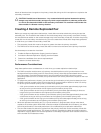Data Replication
The RAID controller modules manage data replication between the primary virtual disk and the secondary
virtual disk. This process is transparent to host machines and applications. This section describes how
data is replicated between the storage arrays that are participating in Remote Replication (legacy). This
section also describes the actions taken by the RAID controller module owner of the primary virtual disk if
a link interruption occurs between storage arrays.
Write Modes
When the RAID controller module owner of the primary virtual disk receives a write request from a host,
the RAID controller module first logs information about the write to a replication repository virtual disk,
and then writes the data to the primary virtual disk. The RAID controller module then initiates a remote
write operation to copy the affected data blocks to the secondary virtual disk at the secondary storage
array.
The Remote Replication (legacy) premium feature provides two write mode options that affect when the
I/O completion indication is sent back to the host: Synchronous and Asynchronous.
Synchronous Write Mode
Synchronous write mode provides the highest level security for full data recovery from the secondary
storage array in the event of a disaster. Synchronous write mode does reduce host I/O performance.
When this write mode is selected, host write requests are written to the primary virtual disk and then
copied to the secondary virtual disk. After the host write request has been written to the primary virtual
disk and the data has been successfully copied to the secondary virtual disk, the RAID controller module
removes the log record on the replication repository virtual disk. The RAID controller module then sends
an I/O completion indication back to the host system. Synchronous write mode is selected as the default
value and is the recommended write mode.
Asynchronous Write Mode
Asynchronous write mode offers faster host I/O performance but does not guarantee that a copy
operation has successfully completed before processing the next write request. When you use
Asynchronous write mode, host write requests are written to the primary virtual disk. The RAID controller
module then sends an “I/O complete” indication back to the host system, without acknowledging that the
data has been successfully copied to the secondary (remote) storage array.
When using Asynchronous write mode, write requests are not guaranteed to be completed in the same
order on the secondary virtual disk as they are on the primary virtual disk. If the order of write requests is
not retained, data on the secondary virtual disk might become inconsistent with the data on the primary
virtual disk. This event could jeopardize any attempt to recover data if a disaster occurs on the primary
storage array.
Write Consistency Mode
When multiple replication relationships exist on a single storage array and have been configured to use
Asynchronous write mode and to preserve consistent write order, they are considered to be an
interdependent group that is in the Write consistency mode. The data on the secondary, remote storage
array cannot be considered fully synchronized until all of the remote replications that are in the Write
consistency mode are synchronized.
99


















